Supercars are designed for a very specific type of customer. Picture someone undoubtedly very well off financially, typically living a busy, flamboyant lifestyle, flying in their private jet to their fancy condo in Dubai, and spending exorbitant amounts of cash on a watch, or a dog.
Their perspective at life is at the total opposite of common folk like you and me. And it’s the same for the cars they own. A supercar is typically the third, or fourth automobile for someone who’s loaded.
Which is why when poor automotive journalists such as myself—folks whose lives are generally spent doing exciting things like tweeting, and chasing down invoices from the outlets we write for—are offered the chance to review a machine like the 2020 McLaren 600LT Spider, the opportunity comes at us as a double-edged sword. On one hand, the little kid inside of us is flipping marbles at the idea of finally living his lifelong dream. On the other hand, our not-so wealthy adult self quickly realizes there are practical challenges involved.
I found that out the hard way when I was thrown the keys to McLaren’s latest lightweight “entry-level” supercar. Living with these things when you can’t afford one can quickly become intense.
(Full diclosure: McLaren Canada contacted me with an opportunity to drive a 2020 McLaren 600LT Spider press unit in Montreal. I was allowed to keep the car for three days, with a strict 217 mile driving limit.)
Why Does It Matter?
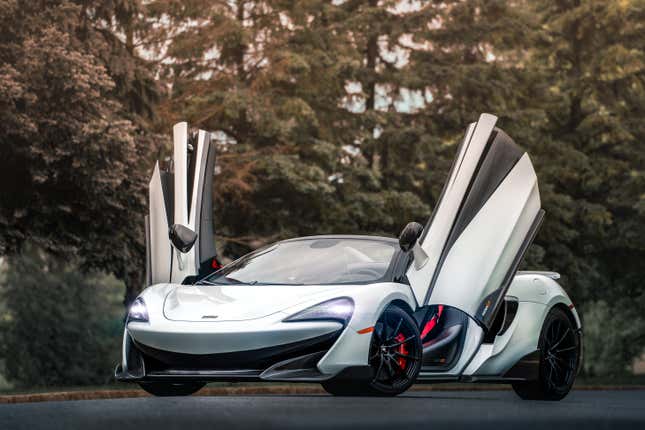
Kristen Lee did a solid deep dive of the thing already, so I’ll let her words explain what this track monster is, and what it can do. I’ve decided to do something a little different than a traditional review. I’m here to share with you how these cars fare during a normal day in a normal life.
And frankly, I don’t know about you, but reading about yet another inaccessible supercar that just broke its own lap record at the Nürburgring is... getting old. At the very least, those sorts of bragging rights have little relevance to anyone.

I will get this out of the way first, though: the McLaren 600LT is a completely insane machine, one that catapults you to your next destination the moment you dare feather the throttle. It’s a scalpel-precise, 592-horsepower, carbon fiber-induced go-kart that’ll splatter your face on the windshield the moment you’ll dare hit the brakes too hard.
Teleportation machines exist, folks, and they have a McLaren logo slapped onto them.
The 600LT also looks properly exotic in roadster form, with its quick-retracting roof that folds neatly between you, and the engine compartment. It allows everyone to see your mug as you cling on for dear life at the wheel of this hyper-technical super machine. And I totally dig the exposed carbon fiber of my white tester, complete with red interior and optional carbon fiber seats from the range-topping Senna.
It’s also worth $256,500 (or $336,822 Canadian like my example), basically the price of a nice middle-class home.
The Supercar Life

Now, I’m not a #SupercarLife type of person. I don’t even own a house. I live in an apartment and I most certainly don’t own a garage. Having a supercar isn’t just about having the money to buy one—it’s also about needing everything that goes around it as well.
I also live in Montreal, one of North America’s worst cities to own a supercar in. Potholes, construction, massive traffic, shitty drivers. It’s all there. And while I did have access to some solid tracks around the city, I wasn’t allowed to bring the car on them. As you can see, I was kind of stuck with a big problem.
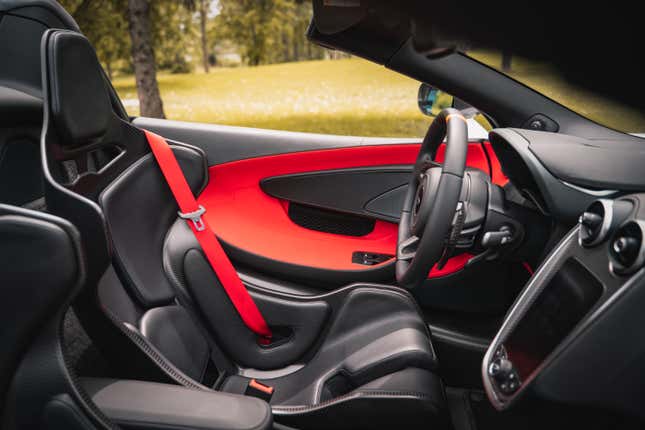
If you’ve ever been to Montreal, you’d know the city is built on an island, with its suburbs known as “shores.” They’re called North and South shores; you may be able to guess from that where they’re located.
I live on the latter, and the car was up north. Because Canadian auto journalists actually have to pick up their press units themselves (they don’t get delivered at home like the Americans), it meant I had to crawl my way through the gridlocks of this construction-infested city with the McLaren.
Following a quick run-down by one of McLaren’s people, I could finally drive off in the 600LT. Slipping inside its carbon fiber tub is actually not bad, even for a man of my stature.
And once inside, those optional Senna seats, which are basically a slab of carbon fiber on which someone glued a cushion-like material, don’t just look bitchin’, they’re actually supportive, but only for a short ride.
I can see how this could work at the track for a few hot laps, but if you’re looking to daily drive your 600LT, I’d recommend sticking to the standard, cushier benches.
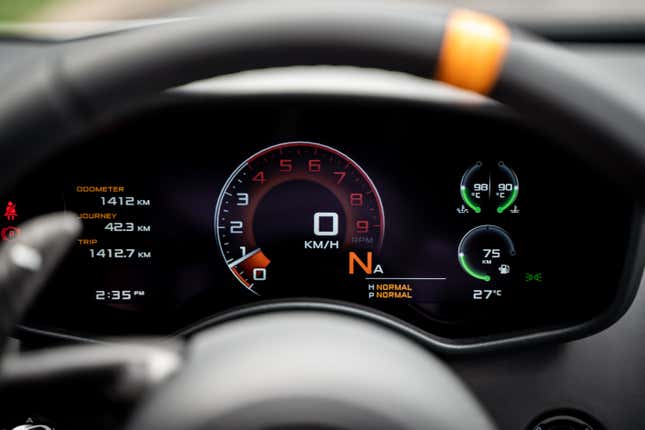
I was immediately instructed to raise the car’s nose to get out of the parking lot. That in itself is a slightly complex procedure operated though a series of unintuitive menus in the gauge cluster. The car needs to be running, with your seat belt buckled and the steering wheel preferably straight for the car’s nose to lift.
Yes McLaren, I’ll make sure to remember that when I’m about to enter all the parking lots.
It’s Not That Daily Friendly
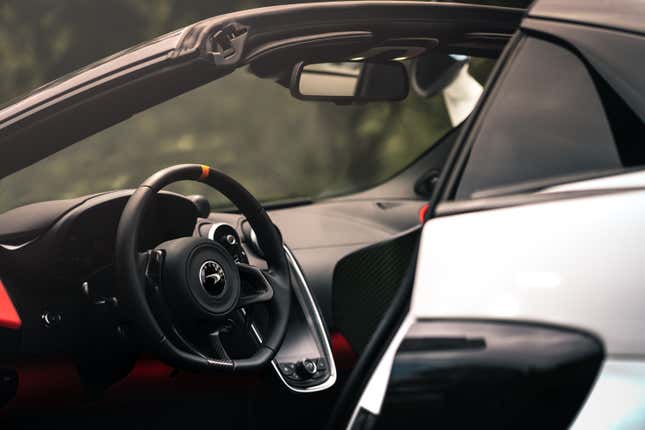
Even in convertible form, the 600LT is first and foremost a track car due to its bare-bones philosophy; the lower weight and increased power make this more specialized than others. Heck, that roof only adds 108 pounds to the car, and I’m told none of the chassis rigidity was compromised in the process. Its suspension is also not McLaren’s hydraulically connected setup which typically underpins some of its road cars—this one uses a vastly more conventional setup.
The result is the 600LT is stiff as hell, which means your back better be in shape when comes time to drive this thing in the everyday world of normally paid human beings.
The first, immediate thing you’re slapped in the face with when driving these things around town is that there are many, many places you wouldn’t even dare drive the car. It’s just too low, too wide and way too expensive to bring it to Costco.
You’ll want to stay away from any area where there’s traffic, people or any form of construction, which basically meant everywhere in my case.

I say people, because obviously you’re going to attract a million eyeballs with one of these bad boys. People don’t just stare, they straight up walk over and make it their own.
I’m not kidding. One guy walked up to the car as I was standing next to it, scissor doors opened, chatting with a friend. He walked right past me like I was a ghost or something, and stuck his entire head in the car, fiddling with things and all. I had to interrupt his fact-finding mission with a polite “Um, excuse me, sir, may I help you?”
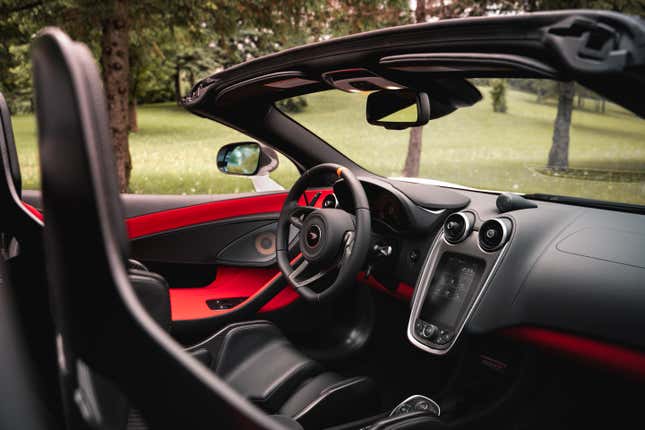
And then there’s the way people behave on the road around it. Because the 600LT is so low to the ground, crossovers and trucks make you feel like a caveman trying to dodge the dinosaurs (I believe this is how you Americans are taught “science”?).
Here they cut you off violently, because they obviously didn’t see you coming. Worse still are the cars that come super close to your flank because the driver is hypnotized from seeing a McLaren out in the open. I tell you, after the first day of living with this thing I was exhausted.
Rain, Apparently, Is Bad

Since I don’t own a garage, I had to park the car in my apartment building parking lot. Luckily enough, I own two spaces of parking, so I was able to park my spouse’s Hyundai Elantra next to the McLaren, acting as a shield against door-scratching douchebags.
But this also meant the poor thing had to sleep outside. And since this was mid-June in Quebec, there was heavy downpour every other day. The McLaren 600LT Spider does not like rain.
You see, this supercar is equipped with a set of upright exhaust pipes, similar to a jet. And they look very, very rad.
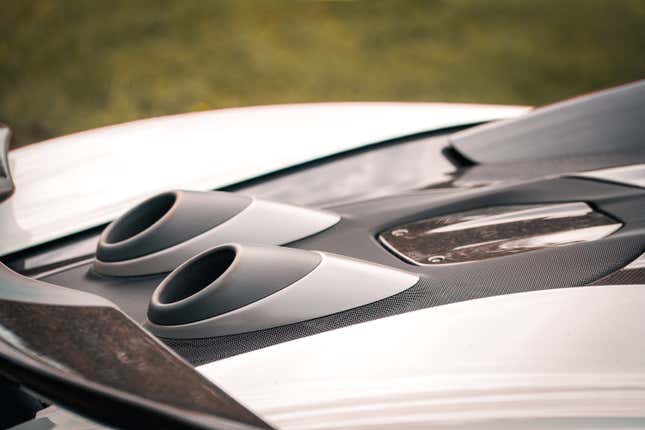
When you downshift the thing at high speeds, those tubes spit out a solid backfire—Bang!—so loud your eardrums instantly go numb. And at night, if you look closely in the rearview mirror, you can spot a tiny flame spewing out of them at times. It’s the kind of stuff you want from your supercar, another feature which makes the 2020 McLaren 600LT Spider feel that more special than a “standard” 570S.
But get this: apparently (and I found out about all of this after) those mufflers don’t like rain too much, because of their vertical position and their closeness to the engine itself. This is why it’s not recommended to leave the car outside when in the wet, or drive it through a conventional car wash.
Which I also tried. It was hell.
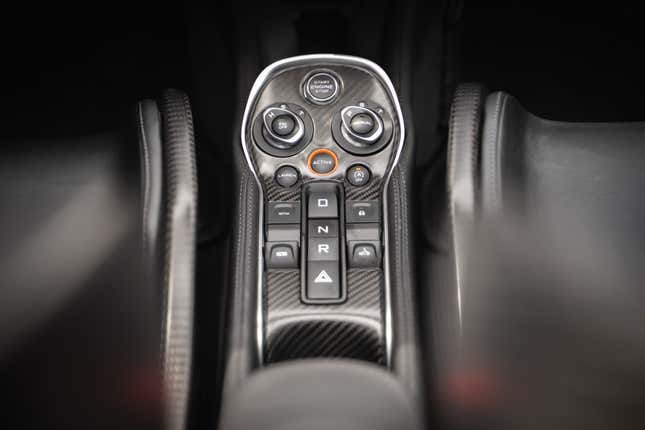
Anyway, the next morning, following a torrential rain storm, I fired up the car and a large, rather worrying cloud of white smoke flew out of those fancy mufflers. The engine sounded off, slightly misfiring on idle. I broke the McLaren!, I thought to myself. My career is over!
After speaking with my local McLaren rep, no harm was done, because one has to assume that these cars are built to tolerate such everyday mishaps—to a point, at least. But you can imagine the intense levels of shit-pants stress I went through thinking I had destroyed the engine. Like I said: the supercar life. I ain’t got it.
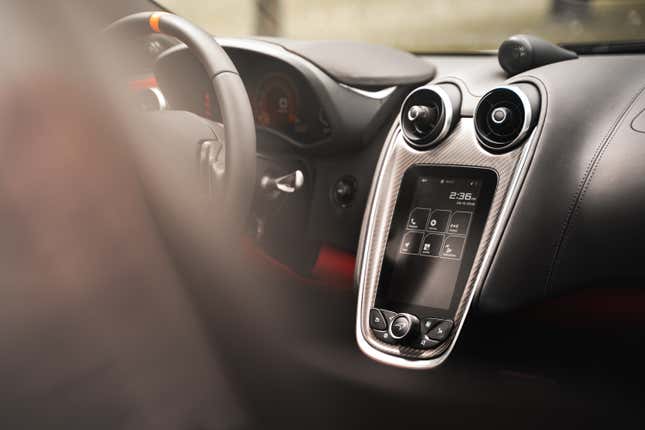
What I didn’t mention though is while it was a hard beast to live with due to my poor-man realities, the 600LT is actually quite easy to see out of. Its engine, while extremely turbo-laggy, has more than ample low-end torque for city cruising, and its steering is terrific, feeling totally natural at all times.
The car has three settings to choose from: Normal, Sport and Track. Both the car’s chassis and engine/transmission can be individually adjusted, and I was amazed at how compliant its suspension was on our god-awful roads.
Meanwhile, the infotainment system is an ergonomic mess. Simple commands like adjusting climate control will lead to important distractions, further increasing the stress level when driving this thing around town.
Verdict

You’re probably thinking that for a potential McLaren buyer, all of these mishaps won’t matter. The person who has the money to buy a machine of this expenditure also has the financial resources to deal with its capricious behavior. My poor-person problems do not bother the rich.
But if you suddenly got this crazy idea of renting a supercar for the weekend because you just got a nice bonus at work, know this: these cars weren’t built for average folk like you and me. And you’d better be prepared, because the fun ends fast when you’re looking for a place to wash the thing without damaging anything.
There are only two places these cars need to be; the garage and the racetrack. That’s it.
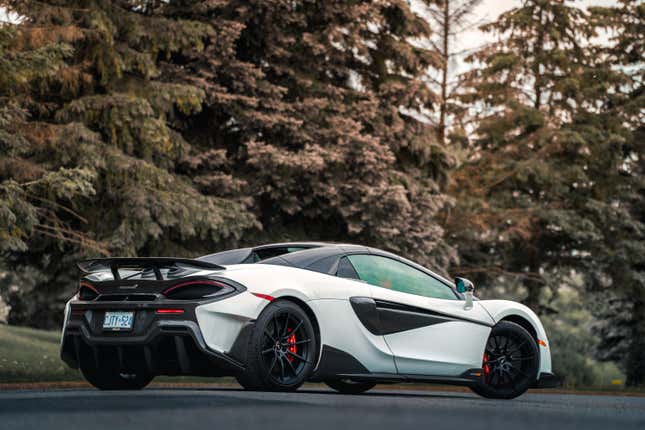
Despite all that, I can tell you with assurance that it’s one of the best performance tools I’ve ever sat my ass in. And I don’t mean any of this to complain about the car—just to educate you on what you might be in for if you want something this extreme.
The last thing I drove that felt this connected to the road was a Campagna T-Rex, but that was essentially a tubular frame with a speed bike engine strapped onto it. That’s how much fun I had driving the 600LT Spider.
But considering the number of gray hairs this thing gave me during the time I had it, I’ll stick to BRZs and Miatas even if I do get suddenly rich, thank you very much.
William Clavey is an automotive journalist in Montreal, Canada and contributes to Jalopnik. He runs claveyscorner.com.
